Saturn AL-31
| AL-31 / 41F | |
|---|---|
 | |
| Saturn AL-31 FN turbofan engine | |
| Type | Turbofan |
| National origin | USSR/Russia |
| Manufacturer | NPO Saturn, UMPO, NPC Saljut |
| Major applications | Sukhoi Su-27 Sukhoi Su-30 Sukhoi Su-35 Shenyang J-11 Chengdu J-10 Chengdu J-20 |
The Saturn AL-31 is a family of military turbofan engines, developed by the Lyulka, now NPO Saturn, in the Soviet Union/Russia, originally for the Sukhoi Su-27 air superiority fighter. It produces a thrust of 123 kN (27,600 lb) with afterburning in the AL-31F, 137 kN (30,800 lb) in the AL-31FM (AL-35F) and 145 kN (32,000 lb) in the AL-37FU variants. Currently it powers all Su-27 derivatives and the Chengdu J-10 multirole jet fighter which has been developed by China.
Variants
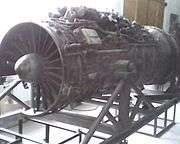 AL-31F
AL-31F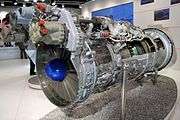 AL-31FP
AL-31FP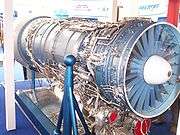 AL-31FN
AL-31FN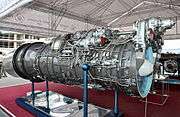 AL-31FM1
AL-31FM1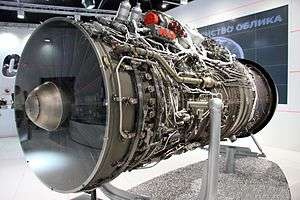 AL-41F1S
AL-41F1S
Summary
| Name | Description | Builder | Year | Thrust | Thrust vectoring | Aircraft | Status |
|---|---|---|---|---|---|---|---|
| AL-31F[1][2][3] | The basic engine developed to power the Su-27 fighter | Salyut, UMPO | 1981 | 123 kN (27,700 lbf) | No | Su-27, Shenyang J-11, Sukhoi Su-30MKK, Sukhoi Su-30 (Salyut) | In service/production |
| AL-31F3 | Improved variant for the naval version Su-33 | Saturn Lyul'ka | 125.57 kN (28,200 lbf) | No | Su-33 | In service/production | |
| AL-31FP | Improved variant for the Indian Su-30MKI with thrust vectoring | Salyut, HAL | 2000 | 123 kN (27,700 lbf) | Yes | Su-30 MKI, Sukhoi Su-30MKM | In service/production |
| AL-31FN[4] | Improved variant for the Chengdu J-10 | Salyut | 2002 | 124.5 kN (28,000 lbf) | No | Chengdu J-10 | In service/production |
| AL-31FN Series 3[5] | Improved variant for the Chengdu J-10B | Salyut | 2013 | 134.3 kN (30,200 lbf) | No | Chengdu J-10 | In service/production[6] |
| AL-31F M1[7] | Improved version for the Russian Air Force | Salyut | 2007 | 135 kN (30,300 lbf) | Yes | Su-27SM, Su-30, Su-34 | In service/production |
| AL-31F M2[8] | Improved version for the Russian Air Force | Salyut | 2012 | 145 kN (32,600 lbf) | Yes | Su-27SM, Su-30, Su-34 | In tests |
| AL-37FU | Advanced derivative for the Su-37 | UMPO | 145 kN (32,600 lbf) | Yes | Su-37 | Experimental derivative for Su-37 | |
| AL-41F-1S (117S)[9] | Advanced derivative for the Su-35 | UMPO | 2010 | 142 kN (31,900 lbf) | Yes | Su-35 | In service/production |
| AL-41F1 (117) | Advanced derivative for the Sukhoi Su-57 | UMPO | 2010 | 147 kN (33,000 lbf) | Yes | Su-57 prototype | In service/early production |
| AL-41F3/FU (30) | Advanced and enhanced variant for the Sukhoi Su-57 | NPO Saturn | 2017 | 93/108 kN (24,000 lbf) or 180 kN (40,000 lbf) | Yes | Su-57 serial | Development/early production |
The AL-31FP and AL-37FU variants have thrust vectoring. The former is used in the Su-30MKI export version of the Su-30 for India & Sukhoi Su-30MKM for Malaysia . The AL-31FP can deflect its nozzle to a maximum of ±15° at a rate of 30°/sec. The vectoring nozzle is used primarily in the pitch plane. The AL-31FP is built in India by HAL at the Koraput facility under a deep technology transfer agreement.
It can tolerate severely distorted air flow from the intake. In the twin-engined Su-27, left and right engines are interchangeable. The Mean Time Between Overhaul (MTBO) for the AL-31F is 1000 hours with a full-life of 3000 hours. Some reports suggested that Russia was offering AL-31F to Iran to re-engine its F-14 Tomcat air fleet in the late 1990s.
According to Saturn`s Victor Mihailovic Chepkin, chief designer of the 117 and 117S engines, the Chinese WS-10 was developed with the aid of the AL-31`s maintenance technical documentation.,[10] this was recently confirmed by AVIC [11] China can domestically produce most AL-31 parts for its own jet engine programs, but still import turbine blades from Russia.[12]
117S
Intended to power the Su-35BM, the izdeliye 117S (AL-41F1S) is an upgrade of the AL-31F that uses technology from the AL-41F. The engine produces 142 kN (32,000 lb) of thrust in afterburner and 86.3 kN (19,400 lb) dry.[13] It features a fan 3% larger in diameter (932 millimetres (36.7 in) versus 905 millimetres (35.6 in)), advanced high- and low-pressure turbines, an all-new digital control system, and provisions for thrust-vectoring nozzles similar to the AL-31FP. This engine will have an assigned life of 4,000 hours and an MTBO of 1,000 hours.[14] The first flight of this engine was completed in an Su-35BM on 20 February 2008.[15] On 9 August 2010, Ufa-based company UMPO started supplying 117S engines (AL-41F1S) intended for Su-35S fighters.[16]
117
Related to the 117S is the izdeliye 117 (AL-41F1), a highly improved AL-31F derivative designed for the Sukhoi Su-57 fighter. The engine features an increased diameter fan, new high and low pressure turbines, and a digital control system (FADEC). According to Sukhoi director Mikhail Pogosyan, the 117 is a new fifth generation engine built specifically for the Su-57. Though the specifics of the 117 engine remain classified, the engine's thrust was increased by 24.5 kN (5,500 lbs) over the AL-31 while the engine weight was reduced by 150 kg (330 lb). The new engine produces 147 kN (33,067 lbf) of thrust in afterburner and has a dry weight of 1,420 kg (3,130 lb) and thrust-to-weight ratio of 10.5:1.[17] Like the AL-31F, the 117 has 4 low-pressure compressor (fan) and 9 high-pressure compressor stages.[18] Mikhail Pogosyan further mentioned that the 117 engine meets the Russian Air Force requirements and will be installed in production Su-57 fighter which will be supplied to the Russian Air Force and prospective foreign clients.[17]
The 117 is an interim engine meant for prototype and initial production batches of the T-50. The definitive second stage for the aircraft is designated izdeliye 30 and will eventually replace the 117 after 2020. The new engine has increased thrust and fuel efficiency as well as improved reliability and lower costs. Bench testing of the new engine will start in 2014 according to the general designer-director of the NPO Saturn Eugeny Marchuk.[19]
30
Around 98 to 108 (or 118) kN supercruise or afterburning up to 178 (or more) kN of thrust force. Built at NPO Saturn (Rybinsk) and NPC Salyut plants.
Specifications AL-41F-1S (117S)
Data from Rosobornexport[21]
General characteristics
- Type: Two-shaft afterburning turbofan
- Length: 494.2 cm (194.6 in)
- Diameter: 93.2 cm (36.7 in) inlet
- Dry weight: 1,604 kg (3,536 lb)
Components
- Compressor: axial, 4 stage fan, 9 stage compressor
- Combustors: annular
- Turbine: 2 single stage turbines
Performance
- Maximum thrust:
- 86.3 kN (19,400 lbf) dry
- 142.2 kN (32,000 lbf) with afterburner
- Turbine inlet temperature: 1,471.8 °C (2,681.2 °F), 1,745 Kelvin
- Fuel consumption:
- 6,813 kg / h
- 24,969 kg / h with afterburner
- Specific fuel consumption:
- 22.37 g / (kN·s) dry
- 51.53 g / (kN·s) with afterburner
- Thrust-to-weight ratio: 5.49:1 (dry), 9.04:1 with afterburner
Specifications (AL-31F)
Data from [22]
General characteristics
- Type: Two-shaft afterburning turbofan
- Length: 4,990 millimetres (196 in)
- Diameter:
- 905 millimetres (35.6 in) inlet;
- 1,280 millimetres (50 in) maximum external
- Dry weight: 1,570 kilograms (3,460 lb)[23]
Components
- Compressor: 4 fan and 9 compressor stages
- Combustors: annular
- Turbine: 2 single-staged turbines
Performance
- Maximum thrust:
- 74.5 kilonewtons (16,700 lbf) dry thrust
- 122.58 kilonewtons (27,560 lbf) with afterburner
- Overall pressure ratio: 23
- Bypass ratio: 0.59:1
- Turbine inlet temperature: 1685 K (1,412 °C (2,574 °F))
- Specific fuel consumption:
Dry thrust: 24.6 g/(kN·s)
Full afterburner: 54.3 g/(kN·s)
- Thrust-to-weight ratio: 4.77:1 (dry), 7.87:1 (afterburning)
See also
Comparable engines
Related lists
References
- Notes
- ↑ "UMPO page on AL-31F". Retrieved 3 April 2018.
- ↑ Salyut page on AL-31F
- ↑
- ↑ "JOINT-STOCK COMPANY «GAS-TURBINE ENGINEERING RESEARCH AND PRODUCTION CENTER «SALUT» - Production - AEROENGINES - AL-31FN". www.salut.ru. Retrieved 3 April 2018.
- ↑ "JOINT-STOCK COMPANY «GAS-TURBINE ENGINEERING RESEARCH AND PRODUCTION CENTER «SALUT» - NEWS - NEWS - FSUE "Gas-Turbine Engineering RPC "Salut" has successfully completed the first phase of engine longevity and performance bench tests in view of future deliveries of a new version of AL-31FN Series 3". www.salut.ru. Retrieved 3 April 2018.
- ↑ "JOINT-STOCK COMPANY «GAS-TURBINE ENGINEERING RESEARCH AND PRODUCTION CENTER «SALUT» - NEWS - NEWS - The FSUE "GTE-RPC "Salut"-produced AL-31FN series-3 engine receives code letter "O1"". www.salut.ru. Retrieved 3 April 2018.
- ↑ "АО «НПЦ газотурбостроения «САЛЮТ» - Продукция - АВИАЦИОННЫЕ ДВИГАТЕЛИ - АЛ-31Ф серии 42 (М1)". www.salut.ru. Retrieved 3 April 2018.
- ↑ "JOINT-STOCK COMPANY «GAS-TURBINE ENGINEERING RESEARCH AND PRODUCTION CENTER «SALUT» - NEWS - NEWS - AL-31F M2 engine contemplated by OKB Sukhogo (Sukhoi Design Bureau)". www.salut.ru. Retrieved 3 April 2018.
- ↑ "UMPO press release". Retrieved 3 April 2018.
- ↑ Коробковwrote, Егор; 14:23:00, 2011-08-17 14:23:00 Егор Коробков korobok12 2011-08-17. "О положении дел в Российском авиамоторостроении. Год 2008". Retrieved 3 April 2018.
- ↑ F_200788. "AVIC report: China's Taihang engine widely deployed in military - People's Daily Online". en.people.cn. Retrieved 3 April 2018.
- ↑ "Is China About to Get Its Military Jet Engine Program Off the Ground?" WSJ, 14 May 2012.
- ↑ Hillebrand, Niels. "MILAVIA Aircraft - Sukhoi Su-35 (Su-27BM) "4++ Generation Flanker"". www.milavia.net. Retrieved 3 April 2018.
- ↑ "NPO Saturn finishes endurance tests for S-117 Engine meant for Su-35". Archived from the original on 28 March 2008. Retrieved 3 April 2018.
- ↑ "Новый истребитель Су-35 полностью выполнил программу первого полета". 20 February 2008. Retrieved 3 April 2018.
- ↑ "Новости - Приволжский федеральный округ - interfax-russia.ru". www.interfax-russia.ru. Retrieved 3 April 2018.
- 1 2 PAK-FA is flying with new engine already installed Archived July 27, 2011, at the Wayback Machine.
- ↑ Butowski, Piotr. "Is Russia’s fifth-generation PAK FA fighter programme still on track?". Air International, June 2015, pp. 76–81. Stamford, UK: Key Publishing.
- ↑ "НПО «Сатурн» создает двигатель поколения 5+ - Еженедельник «Военно-промышленный курьер»". warfiles.ru. Retrieved 3 April 2018.
- ↑ "УМПО начало поставку двигателей 117С для истребителя Су-35С", Interfax, 09.08.10
- ↑ "AL-41F-1S". Rosobornexport.
- ↑ AL=31F specification. china-defense-mashup.com
- ↑ "warfare.be". warfare.be. Retrieved 3 April 2018.
External links
| Wikimedia Commons has media related to Saturn AL-31. |
- Russian Military Analysis - AL-31 F aircraft turbofan engine
- AL-31F on LeteckeMotory.cz (cs,en)
- AL-41F1A (117S) on LeteckeMotory.cz (cs,en)